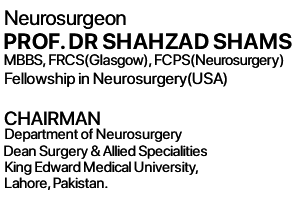Cerebellopontine Angle Tumor
Prof. Shahzad Shams presently works as Head and Professor of Neurosurgery Department at Lahore General Hospital, LGH, Lahore.
Acoustic Tumor
Tran labyrinthine approach and Technique for Acoustic Neuroma surgery
Prof Shahzad shams and his team are the first to start Trans labyrinthine surgery technique and approach which makes the acoustic neuroma surgery safe with complete removal of tumor and excellent results with this minimally invasive key hole surgery.
Prof Shahzad shams and his team are the first and only team in Pakistan to start Trans labyrinthine surgery and approach for acoustic neuroma surgery which is the safest technique for complete removal of tumor. With the help of this technique complete excision with complete safety is now possible and after surgery patient is cured as it is a benign tumor.
Treatment
The total excision of a large acoustic neuroma remained one of the major operative challenges but with Trans labyrinthine approach it is now possible to remove acoustic tumor completely and radically and safely. Safest and best technique performed by only one Team of Prof Shahzad Shams in Pakistan called Trans labyrinthine approach for Acoustic Neuroma surgery.
Acoustic schwannomas
Arise from the 8th cranial nerve and account for 8% of intracranial tumors. Schwannomas occur less frequently on the 5th cranial nerve and rarely involve other cranial nerves. The acoustic schwannoma take origin from the vestibular component of the 8th cranial nerve near the internal auditory meatus, at the transition zone where the Schwann cells replace the oligodendroglia.
Macroscopically, the acoustic schwannoma is lobulated with a capsule that separates it from the surrounding neural structures. Small tumors occupy the pours of the internal auditory canal and, as the tumor grows, the 8th nerve is destroyed and the adjacent cranial nerves become stretched around the tumor.
The 7th nerve is typically displaced on the ventral and anterior surface of the tumor and the trigeminal nerve is carried upwards and forwards by the upper pole. The 6th nerve lies ventral and usually medical to the major mass and the lower cranial nerve and displaced around the inferior pole of the tumor. As the tumor grows medially it compresses and displaces the cerebellum and distorts the brain stem. Large tumors will result in obstruction of the 4th ventricle and hydrocephalus.
Clinical presentation
The presenting features will depend on the size of the tumor at the time of diagnosis. The earlier symptoms are associated with 8th nerve involvement. Tinnitus and unilateral partial or complete sensorineural hearing loss are the earliest features. Episodes of vertigo may occur but these maybe difficult to distinguish from Meniere’s disease. Although the tumor causes compression of the facial nerve, the growth of the tumor is so slow that facial paresis is not evident until the tumor is large.
At that stage 5th nerve compression may be evident, with diminished facial sensation and a depressed corneal reflex. Cerebellar involvement will result in ataxia and stem compression will cause a contralateral hemiparesis. If a large tumor has cause obstructive hydrocephalus the patient will also present with features of raised intracranial pressure.
Radiological investigation
The CT scan will show an enhancing tumor in the cerebellopontine angle. The internal auditory meatus will be widened indicating that the tumor has arisen from the 8th cranial nerve. While there is no difficulty in diagnosing a tumor large enough to be evident on the CT scan, very small acoustic neuromas, which are predominantly within the internal auditory canal, may be more difficult to diagnose. These tumors may be seen on high quality CT scan but are particularly evident using MRI, especially following gadolinium contras
Other investigations
Pure tone audiometry, both by air and bone conduction is an essential part of the investigation of a patient with an acoustic neuroma. Other special auditory test have been developed, including the use of brain stem auditory evoked response test (which is particularly sensitive for changes in the retro cochlear auditory system)and are helpful in diagnosing a small intracanalicular tumor.
Vestibular function is in paired early in patients with acoustic neuromas and nystagmus is a frequent neurological finding. The hall pike caloric test is carried out with the patient suine on a couch and the had raised to 30â‚€C above horizontal, bringing the horizontal canals into the vertical plane with the position of maximum sensitivity the thermal stimuli. Warm and cool water is irrigated and the nystagmus reaction observed. The caloric response on the side of the acoustic nerve tumor is depressed or absent.
The total excision of a large acoustic neuroma remains one of the major operative challenges in what cushing has described as ‘the gloomy corner of neurologic surgery’. The aim of the operation is complete resection of the tumor while sparing the adjacent neural structures. If the patient presents with a large tumor causing serve hydrocephalus and raised intracranial pressure, a preliminary ventriculoperitoneal shunt or ventricular drain may be considered.
Steroid administration prior to surgery is advisable if the tumor is large. The patient is usually positioned on their side, with the head flexed in the three-point headrest, although some surgeons prefer the patient to be in sitting position. The operation is performed through a unilateral “retrosigmoid craniotomy”.






